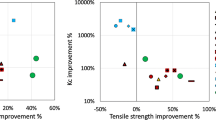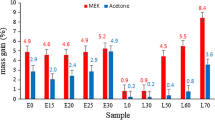Abstract
The failure behavior of cross-linked polymer epoxies with different glass transition temperatures (Tg) was investigated under Mode I fracture at high loading rate using a novel experimental method with in situ observation of the fracture process. By varying the monomer choices, the properties of the epoxies can be tailored to achieve greater resistance to cracking and higher impact toughness. For these experiments, a unique four-point bending specimen was used. High rate experiments were conducted on a modified split Hopkinson pressure bar with pulse-sha**. High speed digital imaging was used to visualize failure initiation. The images were also used with digital image correlation to optically measure the crack opening displacement and crack propagation velocity. The experimental results were used to calculate the energy required to initiate fracture at high loading rate. The results indicate that the critical energy required to initiate fracture at high loading rate was higher for epoxies with lower Tg values, up to an optimum Tg. This dependence of critical energy on the Tg of the epoxy was similar to that which has been previously measured for the epoxy’s impact resistance. In this paper, the experimental methods and results are discussed.
Certain commercial equipment, instruments, or materials are identified in this paper in order to specify the experimental procedure adequately. Such identification is not intended to imply recommendation or endorsement by the Army Research Laboratory, nor is it intended to imply that the materials or equipment identified are necessarily the best available for the purpose.
Access this chapter
Tax calculation will be finalised at checkout
Purchases are for personal use only
Similar content being viewed by others
References
Cho, K., Lee, D., Park, C.E., Huh, W.: Effect of molecular weight between crosslinks on fracture behaviour of diallylterephthalate resins. Polymer 37(5), 813–817 (1996)
Kang, B.U., Jho, J.Y., Kim, J., Lee, S., Park, M., Lim, S.: Effect of molecular weight between crosslinks on the fracture behavior of rubber-toughened epoxy adhesives. J. Appl. Polym. Sci. 79, 38–48 (2001)
Hussain, M., Nakahira, A., Nishijima, S., Niihara, K.: Fracture behavior and fracture toughness of particulate filled epoxy composites. Mater. Lett. 27, 21–25 (1996)
Mostovoy, S., Ripling, E.J.: Fracture toughness of an epoxy system. J. Appl. Polym. Sci. 10, 1351–1371 (1966)
Wakako, A., Kentaro, N., Tadaharu, A., Akihiko, Y.: Fracture toughness for mixed mode I/II of epoxy resin. Acta Mater. 53(3), 869–875 (2005)
Cho, K., Huh, W.: Effect of molecular weight between crosslinks on fracture behaviour of diallylterephthalate resins. Polymer 37(5), 813–817 (1996)
Jiang, F., Vecchio, K.: Hopkinson Bar loaded fracture experimental technique: A critical review of dynamic fracture toughness tests. Appl. Mech. Rev. 62 (2009). Transactions of the ASME
Wu, X.J., Gorham, D.A.: Stress equilibrium in the split Hopkinson pressure Bar test. J. Phys. IV 7(C3), 91–96 (1997)
Chen, W., Lu, F., Zhou, B.: A quartz crystal imbedded split Hopkinson bar for soft materials. Exp. Mech. 40(1), 1–6 (2000)
Weerasooriya, T., Moy, P., Casem, D., Cheng, M., Chen, W.: A four point bending load technique for determination of dynamic fracture toughness for ceramics. J. Am. Ceram. Soc. 89(3), 990–995 (2006)
Weerasooriya, T., Moy, P., Casem, D., Cheng, M., Chen, W.: Fracture toughness for PMMA as a function of loading rate. Proceedings of the 2006 Society of Experimental Mechanics Annual Conference
Gunnarsson, C.A., Sanborn, B., Foster, M., Moy, P., Weerasooriya, T.: Initiation fracture toughness for human cortical bone as a function of loading rate. Proceedings of the 2012 Society of Experimental Mechanics Annual Conference
Syn, C., Chen, W.: Surface morphology effects on high-rate fracture of an aluminum epoxy interface. J. Compos. Mater. 42, 1639–1658 (2008)
Weerasooriya, T., Gunnarsson, C.A., Jensen, R., Chen, W.: Strength and failure energy for adhesive interfaces as a function of loading rate. Proceedings of the 2011 Society of Experimental Mechanics Annual Conference
Knorr Jr., D.B., Yu, J.H., Richardson, A.D., Hindenlang, M.D., McAninch, I.M., La Scala, J.J., Lenhart, J.L.: Polymer 53(25), 5917–5923 (2012)
Masser, K.A., Knorr Jr., D.B., Hindenlang, M.D., Yu, J.H., Richardson, A.D., Strawhecker, K.E., Beyer, F.L., Lenhart, J.L.: Polymer 58, 96–106 (2015)
Bogoslovov, R.B., Roland, C.M., Gamache, R.M.: Impact-induced glass transition in elastomeric coatings. Appl. Phys. Lett. 90, 221910 (2007)
Roland, C.M.: Rubber Chem. Technol. 79(3), 429–459 (2006)
Roland, C.M., Fragiadakis, D., Gamache, R.M.: Compos. Struct. 92(5), 1059–1064 (2010)
Roland, C.M., Fragiadakis, D., Gamache, R.M., Casalini, R.: Philos. Mag. 93(5), 468–477 (2013)
Davies, E.D.H., Hunter, S.C.: The dynamic compression testing of solids by the method of the split Hopkinson pressure bar. J. Mech. Phys. Solids 11(3), 155–179 (1963)
Author information
Authors and Affiliations
Corresponding author
Editor information
Editors and Affiliations
Rights and permissions
Copyright information
© 2017 The Society for Experimental Mechanics, Inc.
About this paper
Cite this paper
O’Neill, J.A., Gunnarsson, C.A., Moy, P., Masser, K.A., Lenhart, J.L., Weerasooriya, T. (2017). Fracture Response of Cross-Linked Epoxy Resins at High Loading Rate as a Function of Glass Transition Temperature. In: Casem, D., Lamberson, L., Kimberley, J. (eds) Dynamic Behavior of Materials, Volume 1. Conference Proceedings of the Society for Experimental Mechanics Series. Springer, Cham. https://doi.org/10.1007/978-3-319-41132-3_8
Download citation
DOI: https://doi.org/10.1007/978-3-319-41132-3_8
Published:
Publisher Name: Springer, Cham
Print ISBN: 978-3-319-41131-6
Online ISBN: 978-3-319-41132-3
eBook Packages: EngineeringEngineering (R0)




